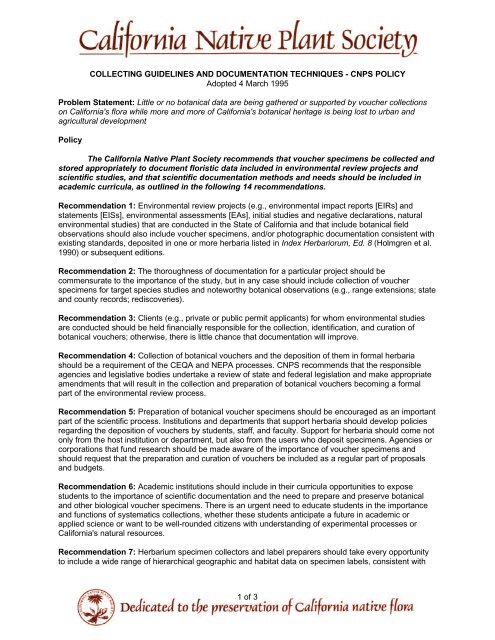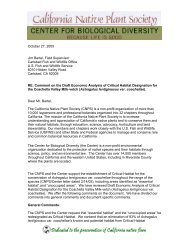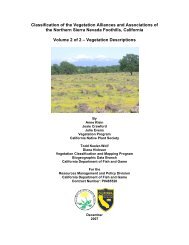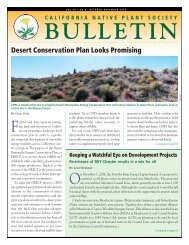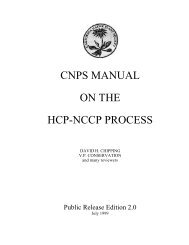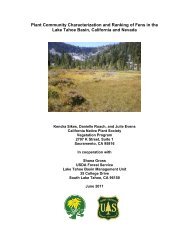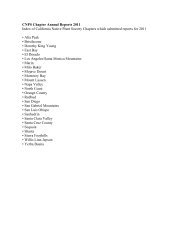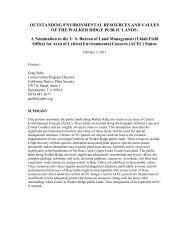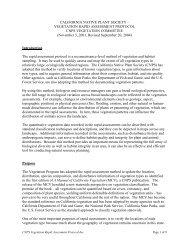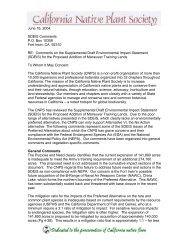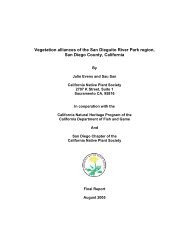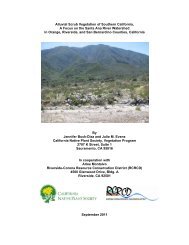PDF Version - California Native Plant Society
PDF Version - California Native Plant Society
PDF Version - California Native Plant Society
Create successful ePaper yourself
Turn your PDF publications into a flip-book with our unique Google optimized e-Paper software.
COLLECTING GUIDELINES AND DOCUMENTATION TECHNIQUES - CNPS POLICY PAGE 2existing standards, that will increase the usefulness of specimens and will make access to the informationpossible through computerization of label data.Recommendation 8: One category of hierarchical data associated with herbarium specimens should bethat which (1) identifies the project for which the specimen serves as a voucher, (2) lists the client,agency, and/or institution associated with the project, and (3) names the report in which the specimen iscited.Recommendation 9: Investigate the feasibility of integrating voucher specimen label data withcomputerization efforts such as the Specimen Management System for <strong>California</strong> Herbaria (SMASCH) toprovide mechanisms for biogeographical and floristic studies.Recommendation 10: CNPS recommends that the Association of <strong>California</strong> Herbaria (ACH) should takean active role in organizing support for and preservation of <strong>California</strong>'s herbaria.Recommendation 11: The Association of <strong>California</strong> Herbaria, CNPS, and CBS should coordinate theiractivities toward (1) preservation of <strong>California</strong>'s botanical heritage; (2) long-term support for <strong>California</strong>'sbotanical education and documentation centers; and (3) improved documentation of <strong>California</strong>'s botanicalresources through implementation of statewide policies regarding the collection, preparation, and curationof voucher specimens for academic and applied environmental and experimental botanical studies.Recommendation 12: Local, state, and federal agencies should strengthen and expand (1) theirrequirements for documentation of environmental reports, particularly the requirement for voucherspecimens; and (2) their relationship with academic institutions and organizations (e.g., ACH, CNPS,CBS) to assist with the professional documentation of environmental work and with the education offuture agency staff and consultants; and (3) their support for herbaria that house voucher specimens,which document the botanical resources of public lands and which document the disclosures in reportsrequired by the CEQA and NEPA processes.Recommendation 13: Regulatory agencies and other responsible parties should consider developing aformal inter-relationship between (1) agencies or their consultants and (2) academic institutions ormuseums, whereby the institutions would provide for fee the botanical documentation portion ofenvironmental reviews. Such an arrangement would reduce or eliminate any burden public agencies orprivate corporations might anticipate collecting and curating botanical voucher specimens, while insuringthe collection and preservation of important specimens.Recommendation 14: The academic institutions of <strong>California</strong> with botany programs and herbaria shouldcontinue and expand support for those programs and herbaria. The documentation and preservation of<strong>California</strong>'s botanical heritage and the future of botanical research depend upon the education ofscientists, resource managers, planners, and consultants who have strong backgrounds in professionalbotanical training.BackgroundAt the workshop entitled "The Future of <strong>California</strong> Floristics and Systematics: Collecting Guidelines andDocumentation Techniques" at the Jepson Symposium convened on 4 June 1994, 14 findings andrecommendations were approved by the workshop participants (51 in attendance) covering four majorareas of concern: (1) documentation of environmental analyses with herbarium voucher specimens, (2)documentation of experimental research with herbarium voucher specimens; (3) presentation ofhierarchical data on specimen labels; and (4) what will the future hold for documentation of <strong>California</strong>'sbotanical heritage?2 of 3
COLLECTING GUIDELINES AND DOCUMENTATION TECHNIQUES - CNPS POLICY PAGE 3To remedy this lack of data collection and providing substantive supporting evidence, the <strong>California</strong><strong>Native</strong> <strong>Plant</strong> <strong>Society</strong> (CNPS) Board of Directors adopts the recommendations of the workshop. CNPSactively encourages that data collection methods be improved as recommended in order to protect<strong>California</strong>'s botanical heritage. The full text of the workshop proceedings is published by the <strong>California</strong>Botanical <strong>Society</strong> (CBS) in Madrono 42(2).<strong>California</strong> <strong>Native</strong> <strong>Plant</strong> <strong>Society</strong>1722 J Street, Suite 17Sacramento, CA 95814(916) 447-26773 of 3


